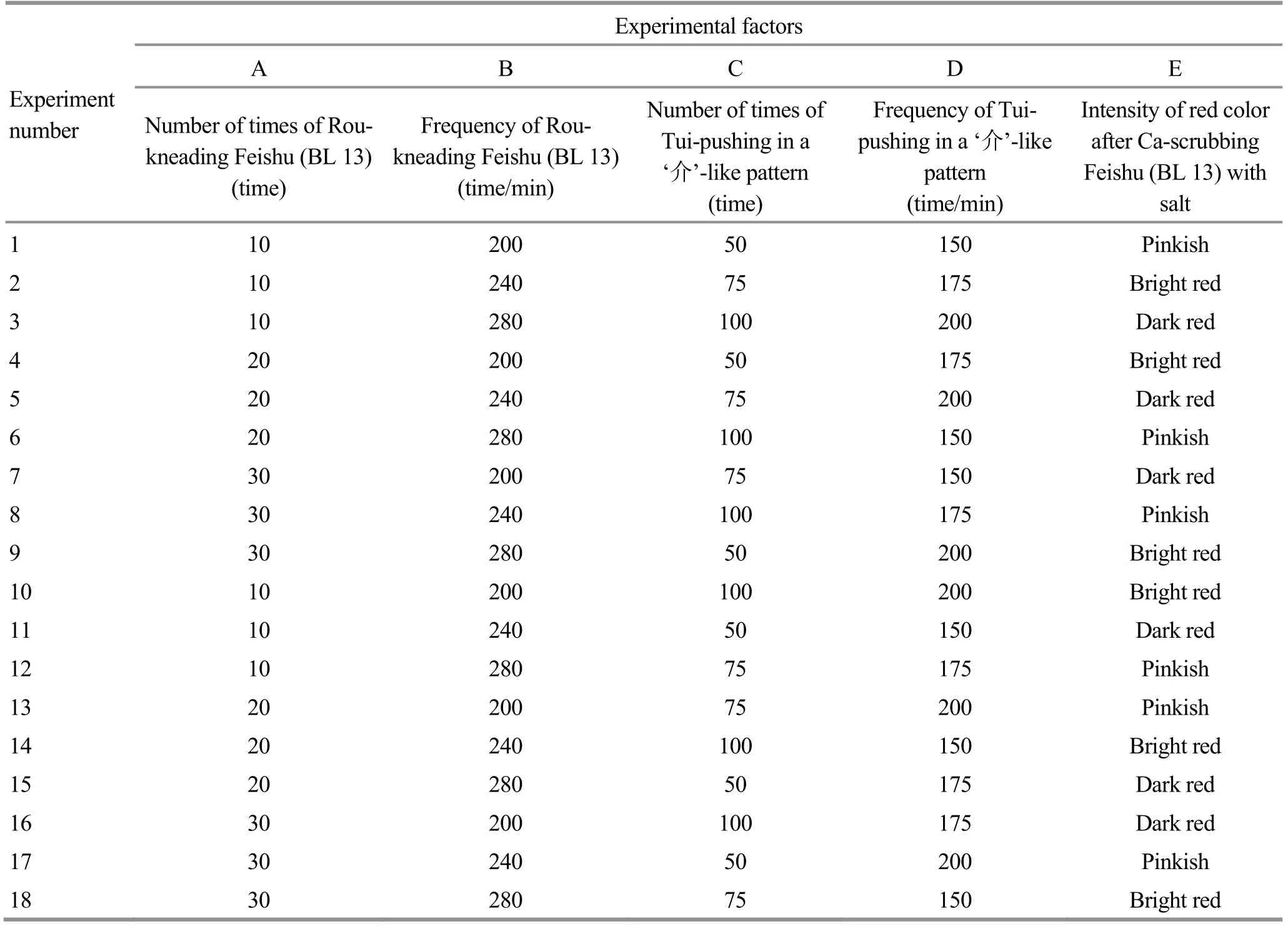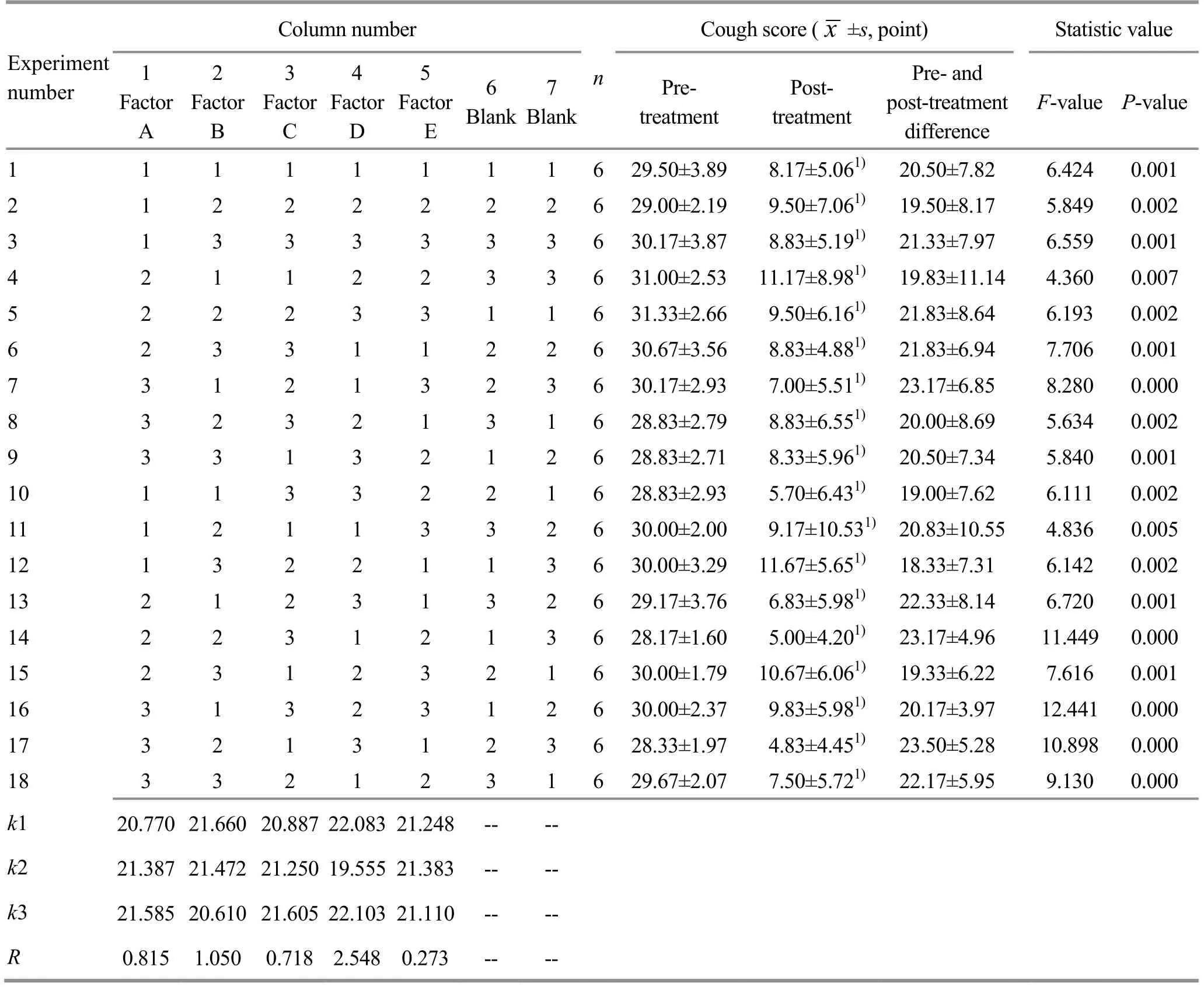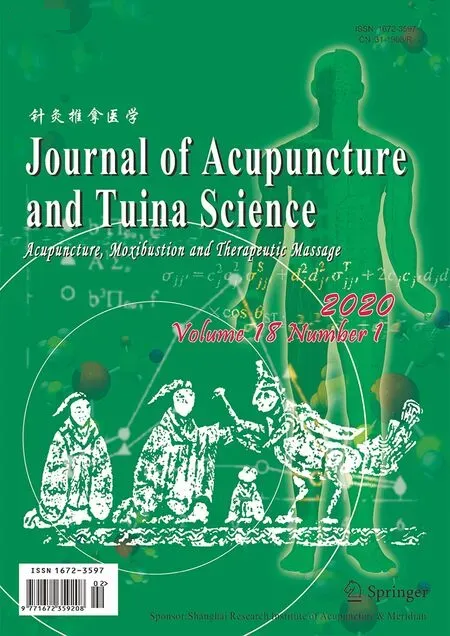Manipulation parameter optimization in Liu’s back tuina therapy for kids’ cough variant asthma in remission stage
Li Xue (李雪), Zhu Bin-ye (祝斌野), Shao Xiang-ning (邵湘宁)
1 School of Acupuncture, Moxibustion &Tuina, Shaanxi University of Chinese Medicine, Xianyang 712000, China
2 The Second Hospital of Shaanxi University of Chinese Medicine, Xianyang 712000, China
3 The First Hospital of Hunan University of Chinese Medicine, Changsha 410000, China
Abstract
Keywords: Tuina; Massage; Pediatric Tuina; Orthogonal Design; Cough; Asthma; Child, Preschool
Cough variant asthma (CVA) is a special type of asthma with chronic cough as the main or only symptom.It is also the precursor symptom of typical asthma, often misdiagnosed as bronchitis or recurrent respiratory tract infection[1-2].CVA is presenting an increasing incidence in kids.Without effective treatment, 30% of CVA may finally turn into typical asthma in kids[3-5].
Liu’s infantile tuina has been awarded one of the first national academic school succession studios and Hunan provincial intangible cultural heritage.Inherited through six generations, it is currently one of the major infantile tuina schools in China[6].Back tuina is a unique multi-manipulation tuina method in Liu’s infantile tuina school.It is a complex manipulation involving the whole projection zone of lungs on the back with Feishu (BL 13)as the center, and a specific treatment for cough[7].Back tuina therapy has been proved effective by clinical practice.Animal experiment also showed that this treatment could intervene the interleukin (IL)-4/signal transducer and activator of transcription 6 (STAT6)pathway, which is associated with respiratory tract infection in CVA rat models[8].Based on which, we adopted an orthogonal design[9]to observe the effects of back tuina therapy on the cough and the level of fractional exhaled nitric oxide (FENO)[10]in kids with remission-stage CVA.This study aimed to find the optimal manipulation parameter combination in tackling this medical issue, to provide evidence for the clinical application of back tuina therapy and lay foundation to conduct large-scale multi-centered clinical trials in the future.
1 Clinical Materials
1.1 Diagnostic criteria
The diagnostic criteria were established according to thePediatrics of Traditional Chinese Medicine[11]andGuideline for Clinical Diagnosis and Treatment of Pediatrics of Traditional Chinese Medicine:Cough Variant Asthma in Children(formulation)[12]: cough lasted over 1 month, with little or no sputum, triggered or aggravated by cold/hot air, exercises, peculiar smell,dust mites, etc., usually at night and/or in early morning.The main symptom was cough (including the frequency,intensity and characteristics).Secondary symptoms were sputum, itchy throat, and irregular food intake,sleep, perspiration and defecation[13].Remission-stage CVA in kids was diagnosed when there presented the main symptom and at least one of the secondary symptoms and the total score of the main and secondary symptoms was <12 points.
1.2 Inclusion criteria
Conformed to the diagnostic criteria; age ranged from 3-4 years old (including 3 but not 4 years old);willing to participate in this trial with good compliance;the informed consent obtained from the guardian.
1.3 Exclusion criteria[14]
With signs of infection; chronic cough caused by other diseases such as throat infection,gastroesophageal reflux, postnasal drip syndrome,bronchial foreign body, mycoplasma infections, etc.;coupled with cardiovascular, kidney, liver, primary immune dysfunctions or hematopoietic disorders;coupled with chronic diseases like rickets, anemia,malnutrition, and tuberculosis, etc.; was participating in other clinical trials; unable to guarantee to complete the trial.
1.4 Dropout and rejection criteria
Quit on one’s own; lost to follow-up visit or failed to finish the required treatment; complications happened during the study so that the patient could not finish the study; the illness got aggravated or there occurred severe adverse reactions; allergic reactions happened during the study; not satisfied with the treatment result during the study; those with poor compliance.
1.5 Statistical methods
The SPSS 21.0 software was used for statistical analyses.Measurement data in normal distribution with inter-group homogeneity of variance were expressed as mean ± standard deviation (±s) and analyzed byF-test.When measurement data were in normal distribution but presented heterogeneity of variance,pseudo-variance analysis was adopted; when measurement data did not completely meet normal distribution, non-parametric test was used.P<0.05 indicated statistical significance.Variance analysis of orthogonal design was used to analyze the major effects of the factors and select the optimal combinations out of the 18 groups.Visual analysis and multi-factor variance analysis were used to establish the range analysis table of orthogonal test.The primary and secondary relations of factors were directly judged through theK-value and rangeR-value, to select the optimal combinations of manipulation parameters.
1.6 General data
A total of 108 kids with CVA in remission-stage were enrolled from the Pediatric Tuina Outpatient of the First Hospital of Hunan University of Chinese Medicine,including 49 females and 59 males, with age ranged 3-4 years old (including 3 years old) at an average of(3.5±0.3) years old, and disease duration ranged from 30-78 d at an average of (49.2±13.1) d.They were divided into 18 groups using the random number table method, and there were no significant inter-group differences in age, disease duration, CVA symptom score and FENO level (allP>0.05), indicating the comparability (Table 1).

Table 1.Comparison of the baselines
2 Methods
2.1 Main instruments
Tuina manipulation apparatus (YUY/TPA-Ⅱ, Shanghai Yu Yang Science and Education Equipment Co., Ltd.,China); concave-convex 3-row 100-channel multifunction electronic sports stopwatch (PC100B/PC100D,Shenzhen Huibo Industry and Trade Co., Ltd., China);nanocoulomb nitric oxide analyzer (Sunvou-P100, Wuxi Sunvou Medical Electronics Co., Ltd., China).
2.2 Orthogonal design
2.2.1 Factors and levels in the orthogonal experiment Based on the orthogonal design, 5 experimental factors were selected: A, the number of times of Roukneading Feishu (BL 13); B, the frequency of Rou-kneading Feishu (BL 13); C, the number of times of Tui-pushing in a ‘介’-like pattern; D, the frequency of Tui-pushing in a ‘介’-like pattern; E, the intensity of red color after Ca-scrubbing Feishu (BL 13) with salt.The maximum, moderate and minimum values of the 5 factors in back tuina therapy were taken as 3 levels.To reduce error, L18(37) orthogonal table was adopted(Table 2).
2.2.2 Grouping
Eighteen experiment numbers were generated according to the L18(37) orthogonal table.Each number was repeated 6 times, i.e., the 108 kids were divided into 18 groups by the random number table method,with 6 cases in each group (Table 3).
2.3 Treatment methods
The treatment was performed based on the operation of back tuina therapy described in theInheritance of Liu’s Infantile Tuina[15].The experimental factors and levels are shown in Table 1 and the 18 groups of parameter combination are shown in Table 2.The frequency and times of manipulation were simultaneously recorded using a stopwatch to ensure the correctness of the manipulation[16].
The tuina treatment was conducted once a day, with a 1-day interval after 5 consecutive days of treatment,and 15 times were considered as 1 course of treatment.

Table 2.Experimental factors and levels of back tuina therapy in L18(37) orthogonal design

Table 3.Back tuina treatment regimen in the 18 groups based on the L18(37) orthogonal design
3 Observation of Results
3.1 Observation items
3.1.1 Kid’s CVA symptom score scale[13]
According to the features of kid’s CVA symptoms, the symptom score recording scale of kid’s CVA of traditional Chinese medicine invented by Prof.Xu Rong-qian was used for efficacy evaluation[17]: four aspects were estimated, including the number of times of cough (0-6 points), severity of cough (0-6 points),duration of cough (0-6 points) and accompanied symptoms (0-16 points).The higher the score, the worse the symptoms.
3.1.2 Measurement of FENO
Nanocoulomb nitric oxide analyzer was used to determine the level of FENO.A higher score indicated worse symptoms.The level of FENO was tested once before and after treatment for comparison and analysis.
3.2 Study quality control
Tuina operation: All tuina manipulations were performed by one same senior infantile tuina physician strictly following the operation required in theInfantile Tuina Therapy.The physician first practiced on the tuina manipulation apparatus repeatedly until his manipulation reached the standard[18]to guarantee the unity and standardization of the force and frequency.
Before the treatment started, the tuina physician was required to master the manipulation operation standard and fill the case report form honestly and in detail.Falsification and omission were not allowed.
The contacts of the kids were carefully recorded to ensure that they would revisit on time to reduce dropout rate.
A randomized controlled design was adopted in this study.Two researchers independently input the data and proofread the data afterwards.Efficacy evaluation was conducted by another physician.
3.3 Results
3.3.1 Comparison of the cough score
The intra-group comparison of cough score demonstrated statistical significance in each group after treatment (allP<0.01).The orthogonal trial analysis showed that the best parameters were A3, B1, C3, D3and E2regarding the effect in improving cough.In improving cough, the factors were listed as D, B, A, C and E in descending order by their effect (Table 4).
3.3.2 Comparison of FENO level
The intra-group comparison of the level of FENO showed statistical significance in each group after treatment (allP<0.01).The orthogonal trial analysis revealed that the best parameters were A3, B1, C3, D1and E2regarding the effect in improving the level of FENO.In improving FENO level, the factors were listed as C, A, E, B and D in descending order by their effect(Table 5).

Table 4.Comparison of the cough score before and after treatment

Table 5.Comparison of the level of FENO before and after treatment
4 Discussion
The increasing incidence of CVA and the high possibility of transforming into typical asthma have gained much attention of pediatric physicians, parents,and the whole society as well.Therefore, the doctors and parents have now focused on the prevention and early intervention in the resting stage[5].Infantile tuina therapy is green, effective, safe and comfortable.These advantages have made it welcome among parents and kids.Cough is the main symptom of CVA in remission stage, and the main pathogenesis is inflammation due to eosinophil infiltration in the airway.As a safe,non-invasive, simple and easy-to-operate method,FENO has now been commonly adopted to evaluate the inflammation state and level in the airway[19].Hence,this study selected cough score and FENO to estimate the clinical efficacy[20].
The statistical and orthogonal analyses showed: each manipulation protocol could improve cough and FENO level of the kids; the optimal manipulation parameter combinations were mostly same regarding the effect in improving cough and FENO level.The possible reason may be related to the features of the acupoints used in the back tuina therapy and its reinforcing-reducing theory.
Back tuina therapy mainly stimulates Feishu (BL 13)and its surrounding skin region of the Bladder Meridian.Feishu (BL 13) internally connects with the lung and is where the lung qi pours in.Stimulating Feishu (BL 13)can regulate the function of the lung[21].Liu’s back tuina therapy applies Rou-kneading, Tui-pushing and Ca-scrubbing manipulations to Feishu (BL 13) till the topical skin becomes red, so as to stimulate the acupoint in a long-lasting deep and safe way.In back tuina therapy, Tui-pushing in a ‘介’-like pattern and Ca-scrubbing Feishu (BL 13) with salt involve not only Feishu (BL 13) but also the skin region of the Bladder Meridian.This region is the projection of lung and tracheas on the back.Stimulation to this region can harmonize qi and blood, regulate the descending function of the lung, and promote expectoration[22].Meanwhile, the medial region of scapula is also a part of the skin region of the Bladder Meridian.The Bladder Meridian defends the human body from the external pathogens.InShang Han Lun Qian Zhu(Simple Annotation on the Treatise on Cold Damage), it records that the Bladder Meridian qi and the lung work together to guard the external of the body.For lung diseases, especially those due to contraction of external pathogens, stimulating the skin region of Bladder Meridian usually can achieve significant efficacy.Liu’s back tuina therapy treats cough and fever by targeting the skin region of Bladder Meridian, which is different from Zhang Zhong-jing regarding the approach, but can achieve similar result.The results of this study also demonstrated that different combinations of the tuina manipulation parameters all can improve cough and non-specific inflammation in the airway.
The orthogonal experiment analysis indicated that the optimal manipulation parameter combination in back tuina therapy in releasing cough and downregulating FENO level should be A3, B1, C3, D1/D3and E2,i.e., the lowest frequency, maximum number of manipulation times and moderate stimulation, which was aligned with the reinforcing-reducing theory in infantile tuina.Kid’s remission-stage CVA is usually due to weak healthy qi and dormant pathogenic qi[23-24].The low frequency is in accordance with the reinforcing method based on frequency; the maximum number of times of manipulation conforms to the reinforcing method regarding operation time and dose;Ca-scrubbing Feishu (BL 13) also belongs to the reinforcing method based on stimulation intensity.Therefore, the optimal manipulation parameter combination is exactly in accordance with the features of the disease and body constitution.This trial has also further verified the rationality and clinical application value of the reinforcing-reducing theory of infantile tuina, and provided evidence for conducting largesample multi-centered clinical trial studying back tuina therapy.
 Journal of Acupuncture and Tuina Science2020年1期
Journal of Acupuncture and Tuina Science2020年1期
- Journal of Acupuncture and Tuina Science的其它文章
- Initiation mechanisms of acupuncture effect: a literature review of basic studies
- Clinical observation of sinew-regulating bone-setting manipulations plus exercise therapy for chronic non-specific low back pain
- Observation on therapeutic efficacy of tuina plus cupping for chronic fatigue syndrome
- Therapeutic efficacy and mechanism of heat-sensitive moxibustion for vascular dementia
- Clinical study on Jin’s three-needle therapy for post-stroke cognitive impairment
- Therapeutic efficacy and mechanism of heat-sensitive moxibustion for adjuvant treatment of depression in Parkinson disease
